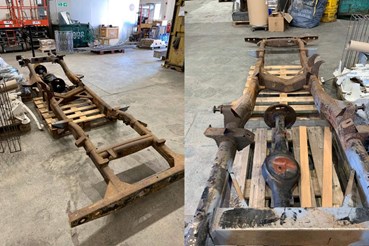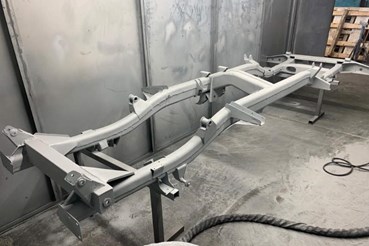Land Rovers have been made with aluminium bodies since they were launched in 1948. These aluminium bodies do not rust so they last for years. Whilst the paint on them degrades and gets damaged and will need stripping and coating but the panels do not rust.
However, it is vastly different for the Land Rover chassis and bulkheads that are made of steel. These steel parts that are painted corrode very quickly, almost as soon as they leave the factory gates!
When you see an old Land Rover it may look in good condition from the outside but as soon as you look at the underside or open the bonnet, a quite different picture emerges. Restoring the car then becomes a much more difficult task for classic car restoration enthusiasts.
Here is how our surface preparation and thermal spray coating services can help restore your classic Land Rover to its former glory.
The Challenge
As we alluded to above, the steel chassis and bulkheads that are found in classic Land Rover's corrode quickly, regardless of how well they are painted. The integrity of both parts is essential in ensuring the Land Rover is roadworthy, as well as functioning as it should off-road.
Some restored Land Rovers have had more than one replacement steel chassis and still suffer from ongoing costly and time-consuming repairs to the steel chassis. After only a short time the original chassis is either corroded beyond repair or is repaired by welding in new steel panels. These new or refurbished steel parts start to corrode again as they did before and it then becomes a never-ending cycle of repair jobs and new steel panels and the restoration process becomes everpresent in warding off the extensive damage of steel corrosion.
Modern vehicles do not corrode as quickly as classic ones did and continue to do so, due to the metal substrate being sufficiently protected by a coating. Thankfully we can supply a solution that provides customers with the same corrosion-resistant service life for their refurbishments as achieved by modern cars.
The Solution
When a chassis or bulkhead is to be refurbished, the first thing we do is remove any paint that still exists using our Pyrolysis Oven Burn Off solution. It works by burning off the unwanted paint/coating whilst leaving the original material with little to no damage.
Prior to any coating being applied, we need to ensure all surfaces from oil and other debris, which could cause contamination. Following the oven burn off, we clean the metal of any leftover corrosion and welding deposits. This is vital for AFC 4100 thermally sprayed zinc coating.
Once we have removed the existing coating and cleaned the metal substrate, we carry out controlled grit blasting with aluminium oxide to increase the surface area of the chassis and bulkheads, to ensure good adhesion of the thermally sprayed coating without the distortions that you get with high-temperature processes such as hot-dip galvanising.
The final stage is to then apply our AFC 4100 thermally sprayed zinc metal deposit which provides a sacrificial corrosion characteristic. The zinc acts as a protective barrier for the steel. Even when the zinc barrier is breached it still protects the steel by corroding first. This is known as sacrificial corrosion and enables the steel chassis, bulkheads or other parts to look like new for many years to come.
The Results
By applying a zinc thermal spray coating, the constant cycle of restoration, corrosion, restoration is broken!


Chassis before and after zinc thermal spray coating of a very rare 1964 vehicle
Our customers end up with a restored classic Land Rover with a chassis and bulkheads that won't begin to corrode as soon as the refurbishment is complete.
Without constant maintenance of the non-mechanical parts, our customers save both time and money, allowing them to enjoy the pleasure they get from having their classic Land Rover on the road instead of the garage!


